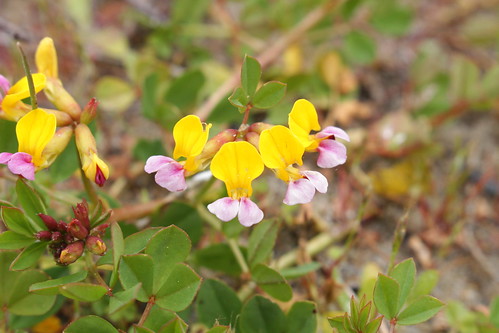Sliding down the slippery slope





Oregon and Washington berry farmers and crop consultants say that the harm inflicted by a hard winter on blackberry bushes is becoming clear.
Bushes are failing to bloom, and some farmers have cut canes to the ground, sacrificing this year’s crop in hopes of rebounding stronger in 2018.
“Probably the hardest decision a farmer has to make is scrap his crop. But if you don’t see blooms, you won’t see fruit,” said Ridgefield, Wash., berry farmer Jerry Dobbins. “The damage is catastrophic. It’s every place.”
Oregon dominates U.S. blackberry production, while berry growers across the Columbia River in southwest Washington have been adding blackberry acres. Growers produced large crops in 2015 and 2016, but saw prices fall. The U.S. is a net importer of blackberries, with berries coming from such countries as Mexico, Chile and Serbia, according to the USDA.
Although this year’s domestic crop apparently will be smaller, Woodland, Wash., berry grower George Thoeny said he fears that imported berries will hold down prices that farmers receive.
“We hope the price will rise some, but we won’t know until the season is over,” Thoeny said. “I think the industry is looking at a disaster.”
The Willamette Valley and southwest Washington weathered a cold winter, followed by a wet spring. March was the second-wettest on record in southwest Washington, according to the National Centers for Environmental Information, which has records dating back to 1885.
John Davis of Crop Production Services said he has never seen a blackberry crop like this in his 38 years as an agricultural consultant in both states. “If you look, there’s damage in every field,” he said.
Although the extent of the damage only recently became evident, he said he believes the cold snaps caused the harm, more than the rain.
“Week by week, I noticed there was more and more damage showing up,” Davis said. “The blackberry crop went from what I thought would be a good crop to marginal.”
Crop consultant Tom Peerbolt said that in parts of Washington County, a prime berry growing area west of Portland, the temperature dropped to 5 degrees. With blackberries coming into full bloom before the July harvest, growers are assessing the damage, he said.
“The blackberry crop is not going to be a full crop this year,” he said. “If we don’t get any additional weather extremes, we can maximize what we’ve got out there.”
Peerbolt said that raspberries, blueberries and strawberries are fine, an observation confirmed by others.
Chad Finn, a berry breeder with the USDA’s Agricultural Research Service at Oregon State University, said freeze damage was spotty.
Berry test plots in Corvallis and at OSU’s North Willamette Research and Extension Center in Aurora survived the cold. Fields in the Forest Grove area west of Portland and nearer the Columbia River Gorge, where cold air pools, sustained damage, Finn said.
Peerbolt said freeze damage was heaviest at farms growing the Marion blackberry variety.
On a tour of farms in Clark and Cowlitz counties Tuesday, Dobbins pointed to fields of Black Diamond and Columbia Star blackberries that were damaged, too.
He estimated that yields in slightly damaged fields will be down 10 percent.
Dobbins cut 5 acres to the ground. As he watches his remaining 55 acres struggle to bloom, he said he wishes he had cut more acres.
He said he produced 550,000 pounds of blackberries last year and lost money because of low prices. He said that he will do well this year to grow 300,000 pounds.
“The price has got to be up, but will it be where it should be?” he said. “I’m under the thumb of offshore fruit.”
The EO Media Group, the parent company of the Capital Press, has assumed management of the Northwest Agricultural Show from Amy and Mike Patrick.
The Patricks, and Amy’s parents, Jim and Shirley Heater, have guided the show for 48 years.
“It is with great confidence that Mike and I transition the event to EO Media Group,” Amy Patrick said. “I believe they have a broad range of resources that can bolster and improve the show, taking it to its 50th anniversary and beyond.”
Joe Beach, editor and publisher of the Capital Press, praised the family’s management of the show.
“The Heater family built the Northwest Ag Show into an Oregon institution. In no small measure the family is the show,” he said. “As a family business ourselves, we have a particular appreciation for the responsibility we have to maintain what they have created. We are happy that the Patricks and the Heaters are working with us on the 2018 show to ensure a smooth transition.”
Amy Patrick has agreed to help EO Media Group through the transition period to maintain continuity. Jim Heater, show founder and longtime manager, will continue to work with the show and provide the move-in/move-out services for exhibitors.
The 49th annual Northwest Agricultural Show will take place Jan. 30 through Feb. 1, 2018, at the Portland Expo Center.
Beach said the Capital Press has had close ties with both the show and its exhibitors for years, so when the show became available it seemed like a natural fit.
“We’re new to the show business” Beach said, “but we bring a fair amount of promotional and management expertise to the venture, and have some exciting ideas about how we can build on the show’s past successes.”
Patrick reflected on her long association with the show.
“It has been my pleasure to work with so many great exhibitors during my time as manager of the Northwest Agricultural Show,” she said. “The show holds a special place in my heart after growing up with the event and learning the ropes from my parents. As I move on to other career ventures, I will continue to be supportive and interested in the event; the exhibitors truly became like an extended family to me.”
SEQUIM, Wash. (AP) — A team with the U.S. Fish and Wildlife Service continues to catch more invasive European green crabs on the Dungeness Spit on the northern edge of the Olympic Peninsula.
The Peninsula Daily News reports 60 crabs had been caught as of Thursday after more traps were placed.
Crews at the Dungeness Wildlife Refuge first found green crabs April 13, which is the first sighting of the crustacean along that section of the peninsula.
Staff with Washington Sea Grant’s Crab Team say the green crab, which some scientists have called one of the worst invasive species on the planet, is identifiable by five spines on each side of its eyes, and can be green, brown or reddish.
Researchers say the crab often is blamed for damaging shellfish harvests and seagrass beds in the northeastern U.S.
JACKSONVILLE, Ore. (AP) — Bill and Barbara Steele moved to this sleepy corner of Oregon to start their own winery after successful, high-powered business careers.
Now, more than a decade later and with award-winning wine to show for their hard work, they are adding a new crop: marijuana.
Oregon’s legalization of recreational pot two years ago created room for entrepreneurial cross-pollination in this fertile region abutting California’s so-called Emerald Triangle, a well-known nirvana for outdoor weed cultivation.
Recreational marijuana won’t be legal in California until next year, but a few miles north of the border in Oregon, a handful of winemakers are experimenting with pot in hopes of increasing their appeal among young consumers and in niche markets.
“Baby boomers are drinking less. Millennials are coming into their time, economically, where in 2016 they were the fastest-growing consumers of wine, both in dollars and volume,” said Barbara Steele, who runs Cowhorn Vineyard & Garden in rural Jacksonville with her husband.
“They’re looking for an experience of ‘wine and weed.’”
The Steeles leased their land to grow 30 medical marijuana plants last year, and this year they are growing double that amount to be branded with the same label as their wine. They started with seeds in plastic cups under incubators in their laundry room, and pride themselves on a “seed to smoke” philosophy.
This year’s crop also is for medical use, but the Steeles are seeing the benefits of the expanding market from legal recreational pot. Their weed was reviewed alongside one of their white wines in Stoner Magazine, an Oregon cannabis publication.
“That conversation is possible here because our quality — the agricultural possibility — is so high. This is an amazing growing region,” Barbara Steele said.
It’s hard to know exactly how many in the wine industry are looking at pot here, but there’s plenty of buzz surrounding the subject.
Some vineyards are ripping out portions of grapes in favor of marijuana plants or leasing land to private growers. Others are talking about wine-and-weed tourism, including high-end shuttles that would stop at local wineries for tastings and at marijuana farms for glimpses of how pot is prepared for market.
“There are a few wineries setting up very large recreational grows right now,” said Brent Kenyon, of the marijuana consulting business Kenyon & Associates, based in southern Oregon. “The ‘weedery’ and the winery. I think that’s huge, and we see it developing.”
But that enthusiasm comes with a caveat. Marijuana is still federally illegal, and wineries must keep their wine and weed businesses separate or risk losing a federal permit that allows them to bottle and sell wine.
That means establishing two distinct lots for tax purposes and keeping two licenses with the state, said Christie Scott, alcohol program spokeswoman for the Oregon Liquor Control Commission, which also licenses recreational marijuana. Vineyards that grow grapes but don’t have a liquor license, however, could get a recreational marijuana license, she said.
In the nearby Illinois Valley, Katherine Bryan is tackling these challenges as she launches a marijuana business with her son.
She owns Deer Creek Vineyards with her husband, but her pot operation will be called Bryan Family Gardens and will operate on land next to the vineyard.
“We want to be as transparent as possible because when you’re under the federal government umbrella for your wines, you have to be very, very careful,” Bryan said.
She plans to grow several hundred marijuana plants with a focus on organic cultivation and an eye toward a high-end market.
They already have some buyers lined up and are installing greenhouses and lighting as they await approval of their recreational license.
“I get $2,000 a ton for my pinot gris grapes, whereas I can make potentially $2,000 or more per pound of cannabis,” Bryan said. “We have 31,000 plants out here for grapes, so I’m pretty sure I can handle 300 to 500 cannabis plants.”
Mark Wisnovsky, of Valley View Winery in Jacksonville, says some vintners are upset because of the stigma associated with marijuana. But his family’s winery was the first in the Applegate Valley in 1971, and everyone thought they were crazy then, too, he said.
The family isn’t cultivating marijuana now, but Wisnovsky has been a vocal supporter of those who want to do so.
Diversifying with weed could save vineyard owners who have overplanted grapes for years, he added.
“A job’s a job, and money’s money, and we have capabilities here that are unique,” he said. “We either take advantage of the situation or let it steamroll over us.”
PALOMINO VALLEY, Nev. (AP) — President Donald Trump’s budget proposal calls for saving $10 million next year by selling wild horses captured throughout the West without the current requirement that buyers guarantee the animals won’t be resold for slaughter.
Wild horse advocates say the change would gut nearly a half-century of protection for wild horses — an icon of the American West — and could send thousands of free-roaming mustangs to foreign slaughterhouses for processing as food.
They say the Trump administration is kowtowing to livestock interests who don’t want the region’s estimated 59,000 mustangs competing for precious forage across more than 40,000 square miles (103,600 sq. kilometers) of rangeland in 10 states managed by the U.S. Bureau of Land Management.
The budget proposal marks the latest skirmish in the decades-old controversy pitting ranchers and rural communities against groups that want to protect the horses from Colorado to California.
“This is simply a way to placate a very well-funded and vocal livestock lobby,” Laura Leigh, president of the nonprofit protection group Wild Horse Education, said about the budget proposal.
The National Cattlemen’s Beef Association and other interests have been urging BLM for years to allow sales of wild horses for slaughter to free up room in overcrowded government corrals for the capture of more animals.
Doug Busselman, executive vice president of the Nevada Farm Bureau, blamed the stalemate on the “emotional and anti-management interests who have built their business models on preventing rational and responsible actions while enhancing their fundraising through misinformation.”
Presidents George W. Bush, Bill Clinton and Barack Obama also grappled with the spiraling costs of managing the nearly 60,000 horses on the range and another 45,000 currently kept in U.S. holding pens and contracted private pastures.
Over the past eight years, BLM’s wild horse budget has more than doubled — from $36.2 million in 2008 to $80.4 million in 2017.
Trump’s budget anticipates the $10 million savings would come through a reduction in the cost of containing and feeding the animals. The savings also would include cutbacks involving roundups and contraception programs.
The 1971 Free-Roaming Wild Horse and Burro Act permits the sale of older, unadoptable animals. But for years, Congress has approved budget language specifically outlawing the sale of any wild horses for slaughter.
Horse slaughterhouses are prohibited in the U.S. but legal in many other countries, including Canada, Mexico and parts of Europe where horse meat is considered a delicacy.
Then-BLM Director Neil Kornze said a year ago that the horses represented a $1 billion budget problem for his agency because it costs $50 million to round up and house every 10,000 horses over their lifetime.
Still, he said the agency had no intention of reversing the long-standing policy.
However, the Trump administration wants a change, saying through the BLM that the “current program is unsustainable and a new approach is needed, particularly when overall federal funding is so constrained.”
It says the budget would allow the agency to manage the wild horse program in a more cost-effective manner, “including the ability to conduct sales without limitation.”
BLM rounded up more than 7,000 horses in 2012, but only about 3,000 in each of the past two years due primarily to budget constraints.
As of March, BLM estimated that more than half of the horses roaming the range were in Nevada (34,780). An additional 13,191 burros were on the range— about half in Arizona.
The BLM asserts that U.S. rangeland can sustain fewer than 27,000 horses and burros.
“The original intent of the act was to make sure those animals had a healthy presence on the range, but also that they be kept at a number that is sustainable,” said Ethan Lane, executive director of the National Cattlemen’s public lands council. “You have horses starving to death ... and irreversible damage to western rangelands.”
The American Society for the Prevention of Cruelty to Animals said Trump’s budget proposal was shocking.
“Wild horses can and should be humanely managed on-range using simple fertility control, yet the BLM would rather make these innocent animals pay for draconian budget cuts with their very lives,” ASPCA President Matt Bershadker said.
Suzanne Roy, executive director of the American Wild Horse Campaign, said the plan could put the horses on the brink of extinction.
“America can’t be great if these national symbols of freedom are destroyed,” she said.
FRESNO, Calif. (AP) — A renowned strawberry researcher in California broke patent law and violated a loyalty pledge to his former university by taking his work with him to profit from it in a private company, a jury in San Francisco decided Wednesday.
Professor Douglas Shaw formed his own research firm with others after retiring from the University of California, Davis, where for years he had overseen the school’s strawberry breeding program, developing a heartier and tastier fruit.
Jurors in the federal court decided that he used seeds developed at UC Davis without gaining the university’s permission.
The rift struck fear in some farmers in California, the No. 1 strawberry-growing state, that it would stymie research and cause them to lose their competitive edge. California last year produced 1.6 million tons of strawberries valued at roughly $2 billion, according to the U.S. Department of Agriculture.
The university’s strawberry breeding program is now under new leadership, providing farmers and consumers with new generations of the fruit, school officials said.
“This federal jury decision is good news for public strawberry breeders at UC Davis and all strawberry farmers throughout California and the world,” said Helene Dillard, dean of the UC Davis College of Agriculture and Environmental Sciences.
After reading the verdicts, Judge Vince Chhabria, who oversaw the trial, scolded both sides, expressing doubt about the sincerity they claimed to have for the strawberry industry.
“If you really care about strawberries, and if you really cared about California’s Strawberry Breeding Program, you would figure out a way... to avoid subjecting them to this custody battle,” he said.
Shaw had first sued UC Davis after he retired, saying that the university unfairly destroyed some of his work and keeps some of his other research locked in a freezer, depriving the world of a better strawberry. He had sought $45 million for lost research. The university countersued.
Shaw, 63, is a giant in the strawberry world, heading the university’s lucrative breeding program for more than two decades alongside plant biologist Kirk Larson. Most of California’s strawberry farmers grow plants developed by Shaw and Larson.
The two men developed 24 new varieties, allowing growers to double the amount of strawberries produced while retaining the fruit’s succulence. They created strawberries that were more pest- and disease-resistant, more durable during long-distance travel and capable of growing during the shorter days of spring and fall.
The partners say their work netted the university $100 million in royalties. How much they themselves made at UC Davis is unclear, but they say they contributed more than $9 million of their own royalties toward the university’s breeding program.
They retired from the university in 2014 because, they said, the school was winding down the program. Working in partnership with growers and nurseries, they launched a business called California Berry Cultivars, based in Watsonville, to develop new strawberry varieties.
Attorney Sharyl Reisman, who represents the professors and the California Berry Cultivars, said that despite the disappointing verdict, her clients wish to find a way to collaborate with the university.
Damages the professors owe in the case will be decided later, the judge said.
A.G. Kawamura, a strawberry farmer, former California agriculture secretary and part owner of the California Berry Cultivars, said the judge’s comments signal a need for much more work to settle the dispute, even after the trial.
“We still believe there’s good reason to hope for a collaborative progress for all parties to move our strawberry industry forward without litigation,” Kawamura said. “We are still committed to being an important part of the California strawberry industry.
WASHINGTON (AP) — There’s a glimmer of hope for America’s ailing honeybees as winter losses were the lowest in more than a decade, according to a U.S. survey of beekeepers released Thursday.
Beekeepers lost 21 percent of their colonies over last winter, the annual Bee Informed Partnership survey found. That’s the lowest winter loss level since the survey started in 2006 and an improvement from nearly 27 percent the winter before.
The U.S. government has set a goal of keeping losses under 15 percent in the winter.
“It’s good news in that the numbers are down, but it’s certainly not a good picture,” said survey director Dennis vanEngelsdorp. “It’s gone from horrible to bad.”
Reduction in varroa mites, a lethal parasite, is likely the main cause of the improvement, said vanEnglesdorp, a University of Maryland entomologist. He credited the reduction in the parasite to a new product to fight the mite and better weather for pesticide use.
The 10-year average for winter losses is 28.4 percent.
“We would of course all love it if the trend continues, but there are so many factors playing a role in colony health,” said bee expert Elina Lastro Nino at the University of California Davis, who wasn’t part of the survey. “I am glad to see this, but wouldn’t celebrate too much yet.”
For more than a decade, bees and other pollinators have been rapidly declining with scientists blaming a mix of parasites, disease, pesticides and poor nutrition.
While usually hive losses are worst in the winter, they occur year round. The survey found yearly losses also down, but not quite to record levels. About one third of the honey bee colonies that were around in April 2016 were dead a year later, the survey found. That’s better than the year before when the annual loss rate was more than 40 percent.
The survey, originally started by the U.S. government and now run by a nonprofit, is based on information from nearly 5,000 beekeepers who manage more than 360,000 colonies. University of Montana’s Jerry Bromenshenk said the study gives too much weight to backyard beekeepers rather than commercial beekeepers.
SALEM, Ore. (AP) — An Oregon timber company reportedly plans to sue its home state for $3.3 million after its plans to buy the Elliott State Forest recently fell through.
The Coos Bay World reports attorneys for Lone Rock Timber Management Company of Roseburg alerted the Oregon State Lands Department of their plans last week in an email.
Lone Rock was the sole bidder for the 82,500-acre forest, which was on sale for $220 million as a way to meet its financial obligation to produce funds for public education. The state land board reversed its decision to sell it earlier this month.
Lone Rock’s attorneys say the company has suffered millions of dollars in out-of-pocket losses and lost business opportunity, and will seek tort claims for misrepresentation and negligence.







Select the newsletter(s) to which you want to subscribe or unsubscribe.